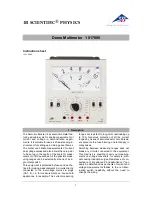Summary of Contents for DL9205
Page 1: ...DL9205 AUTORANGING MULTIMETER operating manual EN 61010 1 CAT III 600V ...
Page 30: ...Notes ...
Page 31: ...Notes ...
Page 1: ...DL9205 AUTORANGING MULTIMETER operating manual EN 61010 1 CAT III 600V ...
Page 30: ...Notes ...
Page 31: ...Notes ...

















